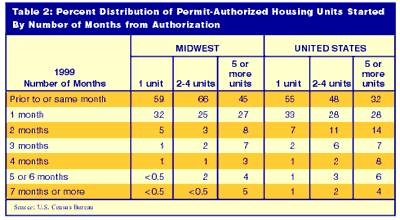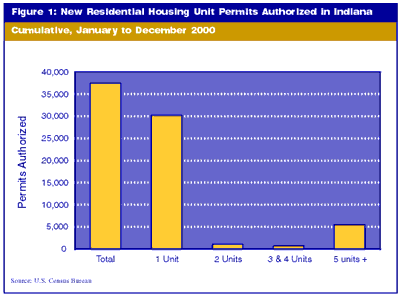Building Permits: Useful Indicator or Meaningless Information?
At the national level, the New Housing Permits Data series is one of the 11 data sets comprising the Composite Index of Leading Economic Indicators. The housing market is generally seen as one of the first economic sectors to rise or fall when economic conditions improve or degrade, and housing permits and starts can be early indicators of activity in the housing market. New residential housing construction generally leads to other types of economic production. The new-housing market is sensitive to interest rate changes and therefore sensitive to changes in interest rates initiated by the Federal Reserve. Locally, the new-housing market is affected by those same national interest rate fluctuations, but it also may be influenced by strictly local factors.
How good, though, are building permits data for local use at the county or place (city or town) level? Do the data get close to the number of housing units eventually constructed? Why are there differences between the cumulative monthly numbers and the annual data? This article explores answers to those questions in order to help the user of such information recognize and understand its limitations.
What's in a name?
Building permits is shorthand for the official Census Bureau description, which is new privately owned housing units authorized by building permits in permit-issuing places. There are a couple of good reasons for the lengthy name. One is to make it clear that the permit is for a new housing unit, and one that will be privately owned. Another reason is to indicate that permits are those issued by an authorized, permit-issuing place, which is usually a city or town but is sometimes a county covering unincorporated territory.
Just a piece of paper?
A permit is still just a piece of paper, right? What most users of building permits information want to know is, how many permits result in a completed housing unit? The federal government conducts monthly surveys of actual housing starts, which result in a set of national estimates of those units where construction has begun. But it cannot afford to do that at the state or local level. There are periodic surveys to discern, by region of the country, just how long it takes from permit to start of construction and how long from start to finish.
Recent survey results show that on average, there is less than a month's elapsed time between the permit authorization and the beginning of construction in the Midwest region (which includes Indiana) and for the nation as a whole (see Table 1).

The majority (96%) of single-family housing units authorized in the Midwest in 1999 were started within two months of permitting (see Table 2).

However, it took an average of seven months to complete a single-family unit in the Midwest, compared to 6.2 months nationally (see Table 3).

There are no definitive answers available to us regarding the number of permit-authorized housing units that go un-built. However, we may be able to infer from the data in Table 2, which show that less than 1% of permits aren't begun within a seven-month period of time, that 1% or fewer don't get started. Local economic and building conditions are the final arbiters on this question.
When are the data available and for what geography?
Monthly data are available for those permit-issuing places that have been asked by the U.S. Census Bureau to voluntarily report on a monthly basis. There are approximately 9,000 such permit-issuing places nationally. The remaining 10,000 places report on an annual basis. An important aspect of this reporting by permit-issuing places is that it is voluntary. As a result, some places don't always report on time or at all in a given year (for example, in 1999, 22 Indiana cities, towns and unincorporated areas had not reported to the Census Bureau). When this occurs, the Census Bureau "imputes" data based on trends from the previous years.
The bottom line: When using monthly building permits data (available on the Web at www.census.gov/construction/bps/), be aware that zeroes may only indicate that the place you have located doesn't report monthly. That is, if a user needs a definitive number of permits for many or all areas in Indiana (or any other state), using the annual data is the most comprehensive set of data. But even the annual data are subject to imputation for those places that didn't send in annual reports.
Where are they?
Building permits data are collected monthly and annually (via two separate reporting mechanisms) down to the place (aka city or town) level and are published via the Census Bureau's Web site. Approximately six weeks separate the reference month (the month for which the data are collected) from the public release of the data. For example, state and place data for December 2000 were available by early February 2001 (see Figure 1).

The majority of building permits data—national, state, metropolitan areas and places—are available on the U.S. Census Bureau's Web site. Annual data for counties are not available via the Web site but are available for purchase from the Bureau. However, annual Indiana county permits data are released on STATS Indiana. For more detailed background and methodological information, turn to the construction statistics component of the Bureau's Web site, where a wealth of detailed statistics and documentation on housing stats, building permits and other construction data are available: www.census.gov/mcd/.
